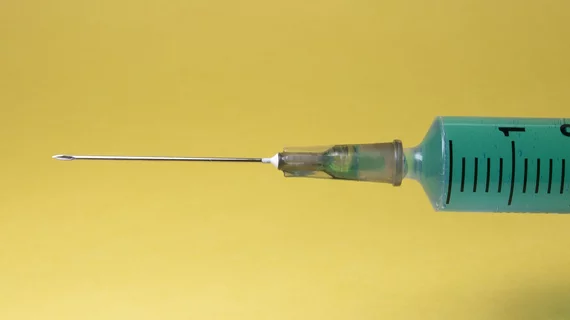How radiology providers can minimize mammography recalls among COVID-vaccinated patients
Radiologists are sharing advice to help others minimize mammography recalls among patients after they have been vaccinated for COVID-19.
This concern first emerged in early 2021, with reports of side effects that could impact physicians’ ability to diagnose breast cancer. At Mayo Clinic Florida, about 1% of vaccinated patients experienced recalls for ipsilateral adenopathy, occurring on the same side as their injection arm. Based on its data, the Jacksonville-based institution has a few pearls of wisdom, according to an analysis published Jan. 26 in Academic Radiology.
“Low recall rates related to vaccine-induced adenopathy are achievable and can limit unnecessary workups, improve access, and promote flexible timing of vaccinations and screening exams,” Santo Maimone, MD, with Mayo Clinic Florida’s Department of Radiology, and co-authors concluded.
For the study, researchers retrospectively analyzed data from their single center, seeking all who received at least one dose of a COVID-19 vaccine prior to screening mammography. More than 2,300 patients met the criteria, imaged between January and May of 2021. Maimone et al. noted no significant difference in the presence of adenopathy when accounting for age, dose or brand. However, the appearance of such swelling of the glands significantly decreased as days from vaccination increased.
Calculations suggested that about 28.5 days is the best cutoff to distinguish the presence or absence of adenopathy on breast images, the authors advised. Out of 24 callbacks in the study, 54% had benign results, 38% were overdue for subsequent follow-ups and 8% were still undergoing surveillance at the time of the study. None required biopsy or unearthed a malignancy.
Based on their findings, Maimone and co-authors believe it’s crucial that radiologists receive accurate vaccination information at the time of the exam.
“This study demonstrates the ability to minimize recalls for vaccine-induced adenopathy, endorsing a less conservative framework for practices to continue to screen patients despite vaccination and booster timing,” the authors wrote. “Facing the potential challenge of continued vaccination rollouts and routine vaccine boosters, this approach helps to avoid inefficient workups that can burden practices while also giving patients more flexibility and confidence to undergo the exams and vaccinations they desire.”

